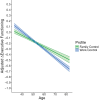Patterns of Perceived Control That Buffer Against Cognitive Decline in Midlife and Old Age
- PMID: 40394865
- PMCID: PMC12202204
- DOI: 10.1093/geronb/gbaf081
Patterns of Perceived Control That Buffer Against Cognitive Decline in Midlife and Old Age
Abstract
Objectives: The relationship between domain-general or global perceptions of control and cognition is well-established. However, little is known about how these domain-general beliefs combine with domain-specific perceptions in central life domains to form multifaceted patterns of control that may buffer against cognitive declines in midlife and old age.
Methods: We used 9-year data from the Midlife in the United States Study (n = 2,734, Mage = 55 years, range = 33-83; 58% female) to identify profiles of domain-general (personal mastery, perceived constraints) and domain-specific control over central life domains (health, work, finances, others' welfare, child relationships, and partner relationship). We subsequently assessed profile differences in 9-year trajectories of cognitive aging and whether these differences became pronounced in old age.
Results: Factor mixture models showed that 4 common profiles emerged: low control, family control, work control, and domain-specific control. Autoregressive ANCOVAs showed the family control and work control profiles experienced the least 9-year decline in executive functioning (F3,2330 = 3.46, p = .016). Moderation models showed the family control profile experienced less decline in executive functioning than the work control profile, but only in old age (b = -0.006, p = .020). Supplemental analyses showed profile differences in cognitive aging were (a) mediated by theory-derived process variables (positive and negative affect) and (b) extended to a broader suite of health-related developmental outcomes (functional limitations, chronic conditions, and mortality).
Discussion: Findings inform lifespan theories of development by documenting meaningful patterns of domain-general and domain-specific control that have implications for healthy cognitive aging.
Keywords: Cognitive aging; Control belief profiles; Domain-specific; Latent profile analysis; Person-centered approach.
© The Author(s) 2025. Published by Oxford University Press on behalf of the Gerontological Society of America.
Conflict of interest statement
None.
Figures



Similar articles
-
Combinations of light, moderate, and vigorous physical activity in midlife and old age: implications for healthy cognitive aging.Ann Behav Med. 2025 Jan 4;59(1):kaaf064. doi: 10.1093/abm/kaaf064. Ann Behav Med. 2025. PMID: 40834402
-
Characterizing Cognitive Dispersion and Its Correlates Across the Adult Lifespan in MIDUS.J Gerontol B Psychol Sci Soc Sci. 2025 May 8;80(6):gbae201. doi: 10.1093/geronb/gbae201. J Gerontol B Psychol Sci Soc Sci. 2025. PMID: 39786429
-
Multi-domain interventions for the prevention of dementia and cognitive decline.Cochrane Database Syst Rev. 2021 Nov 8;11(11):CD013572. doi: 10.1002/14651858.CD013572.pub2. Cochrane Database Syst Rev. 2021. PMID: 34748207 Free PMC article.
-
How lived experiences of illness trajectories, burdens of treatment, and social inequalities shape service user and caregiver participation in health and social care: a theory-informed qualitative evidence synthesis.Health Soc Care Deliv Res. 2025 Jun;13(24):1-120. doi: 10.3310/HGTQ8159. Health Soc Care Deliv Res. 2025. PMID: 40548558
-
Drugs for preventing postoperative nausea and vomiting in adults after general anaesthesia: a network meta-analysis.Cochrane Database Syst Rev. 2020 Oct 19;10(10):CD012859. doi: 10.1002/14651858.CD012859.pub2. Cochrane Database Syst Rev. 2020. PMID: 33075160 Free PMC article.
References
-
- Agrigoroaei, S., & Lachman, M. E. (2011). Cognitive functioning in midlife and old age: Combined effects of psychosocial and behavioral factors. The Journals of Gerontology: Series B, 66B(Suppl. 1), i130–i140. https://doi.org/ 10.1093/geronb/gbr017 - DOI - PMC - PubMed
-
- Brim, O. G., Ryff, C. D., & Kessler, R. C. (2004). How healthy are we?: A national study of well-being at midlife. University of Chicago Press.
-
- Carstensen, L. L. (2006). The influence of a sense of time on human development. Science, 312(5782), 1913–1915. https://doi.org/ 10.1126/science.1127488 - DOI - PMC - PubMed
-
- Carstensen, L. L., & Hershfield, H. E. (2021). Beyond stereotypes: Using socioemotional selectivity theory to improve messaging to older adults. Current Directions in Psychological Science, 30(4), 327–334. https://doi.org/ 10.1177/09637214211011468 - DOI - PMC - PubMed
-
- Carstensen, L. L., Isaacowitz, D. M., & Charles, S. T. (1999). Taking time seriously: A theory of socioemotional selectivity. The American Psychologist, 54(3), 165–181. https://doi.org/ 10.1037//0003-066x.54.3.165 - DOI - PubMed
MeSH terms
Grants and funding
LinkOut - more resources
Full Text Sources
Medical
Miscellaneous

